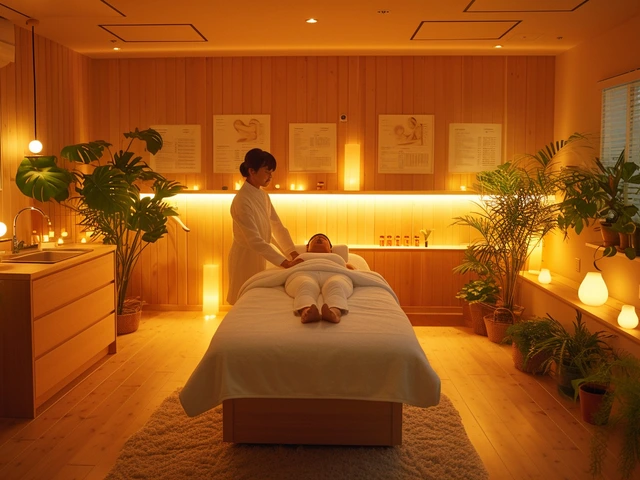Enhance Your Wellness with Neuromuscular Massage Therapy

Have you ever felt like no matter how much you try to relax, certain muscle aches just don't seem to go away? Enter neuromuscular massage, a specialized form of therapy designed particularly for those deep-seated pains that make everyday tasks a challenge.
This type of massage therapy is not your typical spa treatment—it dives deeper, targeting specific areas of muscle tension and pain. By applying precise pressure using fingers, knuckles, or elbows, it reaches those layers of muscle that are often neglected, providing a path to genuine relief and recovery.
- What is Neuromuscular Massage?
- Key Benefits
- Ideal Candidates
- What to Expect During a Session
- Aftercare and Continued Health
What is Neuromuscular Massage?
Neuromuscular massage is much more than your typical stress-relief massage. It is a precise and methodical form of deep tissue massage designed to harmonize the central nervous system with the musculoskeletal system. The technique meticulously focuses on pinpoint areas of muscle tissues, ligaments, and tendons that are often contracted due to stress and overuse. By applying a specified and sustained pressure onto these areas, the therapy aids in releasing the stress knots, and consequently reduces pain and discomfort.
The history of neuromuscular massage is rooted in therapeutic practices that have been refined over decades. Initially developed to manage chronic pain conditions, this type of therapy integrates knowledge from various fields including biomechanics, anatomy, and physiology to provide a comprehensive treatment. The complex interplay of the body's structural and neurological functions dictates the unique approach that neuromuscular massage takes towards healing and wellness.
Experienced therapists practicing neuromuscular massage use a range of techniques including static pressure, friction, and a series of strokes that deepen proportionally to the body’s graded response. This tailored approach ensures that the therapy is not just generic but adapted to the patient’s specific physiological and health needs. Key benefits of this therapy include improved circulation, reduced pain, enhanced mobility, and a noticeable reduction in stress levels.
In terms of practical application, neuromuscular therapy has shown significant results in treating conditions like lower back pain, migraines, sports injuries, and even issues like temporomandibular joint pain (TMJ disorders). It stands out not only for the immediate relief it provides but also for the long-term health benefits it encourages by promoting better posture, improved nervous system function, and stronger resilience against physical stressors.
While more clinical studies are beneficial, countless anecdotes praise the efficacy of neuromuscular massage. Each session can be seen as both therapeutic and educational, as therapists often incorporate advice on maintaining muscle health, posture, and relaxation techniques into their treatment, making it not just a therapy but a holistic approach to health.
Key Benefits
Neuromuscular massage therapy offers a myriad of benefits that can significantly improve your quality of life. This powerful form of therapy not only aids in alleviating chronic pain but also plays a crucial role in enhancing overall muscle performance. By applying specialized techniques, neuromuscular massage helps release trigger points—hyperirritable spots in the skeletal muscle. These are often the root cause of pain cycles, referring discomfort far beyond their actual location.
Another profound benefit is the improvement in circulation. Good blood flow is essential for health, bringing nutrients to tissues and washing away toxins. By relaxing the muscles and reducing the release of stress-related hormones, neuromuscular massage facilitates a better flow of blood and lymph fluids. This not only aids in faster recovery from muscle fatigue but also enhances energy levels, making you feel revitalized and ready to tackle your day with new vigor.
For those who wrestle with anxiety or depression, the calming impact of neuromuscular therapy on the nervous system should not be underestimated. It can substantially reduce levels of stress and anxiety, promoting a sense of well-being. This mental health improvement is notably significant for people with chronic pain, which can often lead to or exacerbate psychological distress.
In terms of physical rehabilitation, neuromuscular massage plays a pivotal role. Whether you're recovering from an injury or dealing with the impacts of age-related muscular degeneration, neuromuscular therapy can aid in enhancing mobility and flexibility. The targeted massage techniques reduce stiffness and improve range of motion, allowing for a smoother and more comfortable movement.
Lastly, it is vital to mention the role of neuromuscular massage in posture correction. Many of us suffer from poor posture due to various lifestyle habits. Neuromuscular therapy addresses this by rebalancing the body's muscles and joints. This not only helps in reducing the strain on certain parts of the body but also improves your overall alignment and function. The result is a noticeable improvement in posture and a reduction in the discomfort that comes with it.
Ideal Candidates
Neuromuscular massage therapy isn't for everyone, but it holds significant benefits for certain groups of people. Primarily, it is incredibly beneficial for individuals who suffer from chronic pain, be it due to lifestyle choices, work-related issues, or more chronic conditions like fibromyalgia. People who spend long hours in front of a computer or who engage in heavy physical activity often accumulate stress and tension in specific muscle groups, making them ideal candidates for this therapy.
Additionally, athletes or anyone engaged in regular physical activity can greatly benefit from neuromuscular massage. The precise techniques used in neuromuscular therapy helps address injuries from repetitive movements and can accelerate the recovery process. This makes it a preferred choice for sports enthusiasts who need a faster return to their peak performance levels.
Those undergoing physical rehabilitation, such as post-surgery patients, have also found neuromuscular massage to be a valuable part of their recovery strategy. By improving blood circulation and reducing muscular tension, the therapy can aid significantly in enhancing overall mobility and easing the rehabilitation process.
Stress and poor posture are also triggers for muscular discomfort which can be elegantly addressed through the methods of neuromuscular massage. Office workers, drivers, teachers, and others who maintain a similar pose for extended periods often experience significant relief after a session of this targeted massage therapy.
It's important to note that while neuromuscular massage is widely beneficial, it may not be suitable for everyone. Persons with certain medical conditions such as acute inflammation, skin infections, or severe osteoporosis might need to avoid this type of massage or consult with medical professionals before beginning therapy. As with any treatment, personalized advice from a healthcare provider is crucial to determine if neuromuscular massage is the right approach for your specific condition and health status.
What to Expect During a Session
Walking into your first neuromuscular massage session might feel a bit daunting if you're not sure what to expect. However, be assured that the main goal of the session is to pinpoint and alleviate areas of muscle tension and chronic pain. Initially, your therapist will likely conduct a thorough assessment that may include a review of your medical history and a physical examination that focuses on your range of motion and muscular imbalances. This meticulous outset ensures that the treatment is tailored specifically to your needs.
Once the assessment is complete, the actual massage begins. Unlike standard relaxation massages that cover the entire body in one session, neuromuscular therapy is more targeted. Your therapist will use their hands, fingers, and sometimes elbows to apply sustained pressure to affected muscle groups. The process can be quite intensive as the goal is to reach deep into the soft tissue to break the cycle of pain and spasms. Therefore, communication during the session is key—expect to provide feedback on the level of pressure and sensation you experience throughout the procedure. This dialogue ensures that the therapy remains within your comfort zone and is effective in addressing the deep tiers of muscle tension.
This type of therapy is known for its directive approach, but it is also adaptable depending on individual tolerance and the severity of the muscle complaint. For instance, therapeutic touch and manual manipulation techniques may vary to suit the depth of tissue engagement required. Some therapists might also incorporate movement into the session; such practices help to facilitate the re-education of the muscles, enhancing mobility and pain relief. It’s not uncommon for patients to feel immediate relief or notice marked improvement in their range of motion shortly after the session.
Throughout the session, therapists typically maintain a generous amount of dialogue to not only tailor their techniques but also to educate you on various aspects of muscle health. They might explain the connection between muscle knots and your everyday stress and provide tips on maintaining muscle health through stretches or posture improvements. In essence, while the session focuses profoundly on alleviating distress in the muscle layers, it also profoundly raises your awareness about your body’s muscular functions and general health maintenance.
Aftercare and Continued Health
Once you’ve experienced the profound effects of neuromuscular massage, maintaining those benefits requires a dedicated approach to aftercare. This stage is crucial, as it helps prolong the therapy’s positive impacts and prevents the recurrence of muscle tension and pain. A thoughtful aftercare plan can transform temporary relief into lasting health improvements.
Hydration is the first key step. After a neuromuscular massage session, it's vital to drink plenty of water. This helps flush out toxins that were released from your muscles during the massage. Experts suggest aiming to drink at least eight glasses of water throughout the day following your treatment. This simple act aids in quicker recovery and reduces the likelihood of muscle soreness.
Another fundamental component of aftercare involves gentle stretching. Incorporating light stretches into your daily routine can enhance muscle flexibility and boost blood circulation. It’s important not to overstretch, as the muscles are very receptive after such intense manipulation. Performing stretches that target the areas treated during the massage can significantly help in maintaining the elasticity and health of the muscle tissue.
Proper nutrition also plays an essential role in your recovery. Foods rich in antioxidants, such as berries, nuts, and leafy greens, can help reduce inflammation. Omega-3 fatty acids, found in fish like salmon and mackerel, are also beneficial for their anti-inflammatory properties. Combining good hydration with a balanced diet accelerates tissue repair and wellness maintenance.
Rest is crucial. Your body needs time to heal and reset after the detailed work of a neuromuscular massage. Avoid strenuous activities for at least 24 to 48 hours post-session to allow your body to adapt and heal. This downtime is essential as it helps consolidate the therapeutic effects and supports muscle recovery.
Finally, consistent follow-up treatments are recommended to deeply address chronic issues and aid in long-term muscle health. Regular sessions help manage pain, improve mobility, and sustain muscle function. While the frequency of these follow-ups depends on individual conditions and therapeutic goals, generally, a session every two to four weeks is effective for maintaining optimal muscle health and ensuring long-term benefits for your body.





